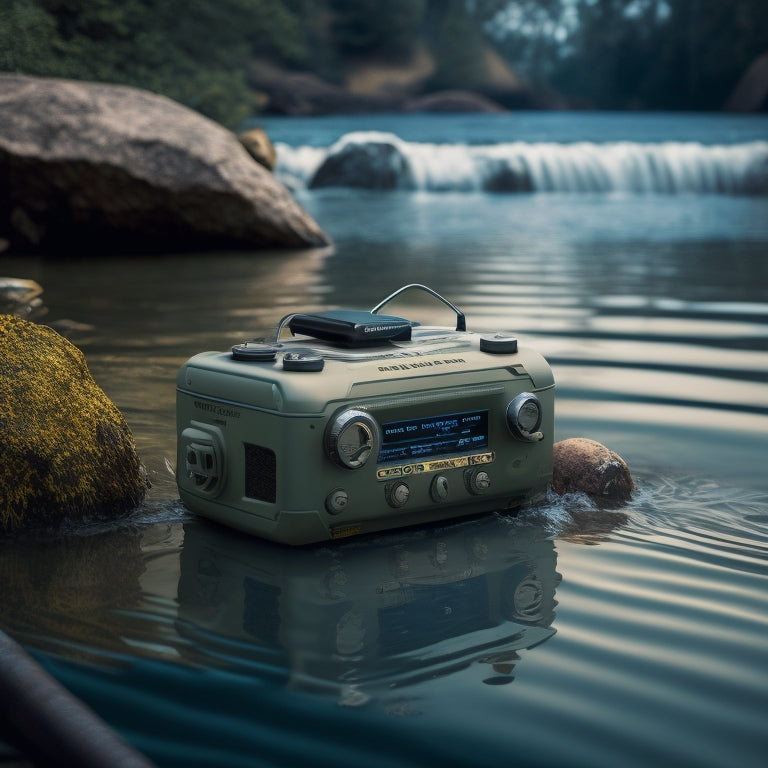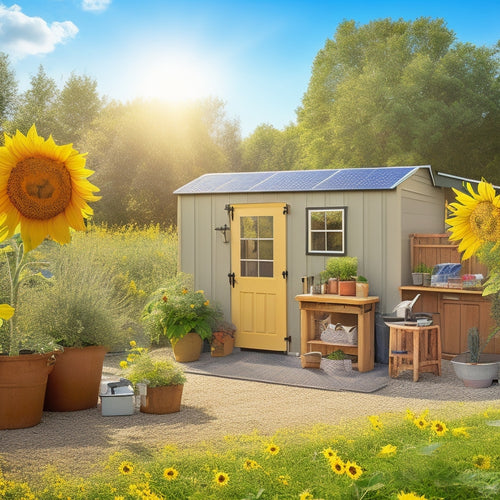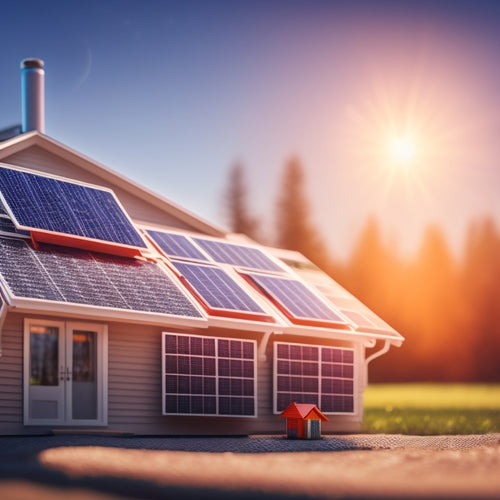
5 Best Waterproof Radios for Camping Hiking and Emergencies
Share
When it comes to camping, hiking, or wilderness emergencies, a waterproof radio is essential for reliable communication and timely rescue operations. To guarantee you stay connected, look for a radio with a high IP rating, such as IPX7, which can withstand immersion in water for 30 minutes. A hand crank power option is also important, providing an eco-friendly energy source during battery depletion. Additionally, multiple band reception capability and clear signal strength are significant for communicating with emergency services and receiving NOAA weather alerts. Now, explore the top 5 waterproof radios that meet these critical requirements for your next expedition.
At a Glance
- Choose a waterproof radio with IPX7 or higher rating for reliable performance in harsh weather conditions.
- Select a radio with multiple power sources, including hand crank and solar options, for off-grid sustainability.
- Opt for a radio with clear signal strength, advanced noise reduction, and wider frequency range for dependable communication.
- Consider a radio with emergency features, such as NOAA weather alerts, distress signals, and rapid alert systems, for timely rescue operations.
- Ensure the radio has multiple band reception capability, including AM, FM, and shortwave frequencies, for access to essential information and communication.
Reliable Communication in Wilderness
When you're camping in the wilderness, you need a waterproof radio that can withstand rugged weather conditions and maintain a clear signal strength.
A radio's ability to resist water, dust, and extreme temperatures is vital in ensuring reliable communication. With the increasing popularity of off-grid excursions, having a reliable energy source, such as a solar generator for camping, is also essential for powering devices like radios.
You'll want to look for features such as IP67 or higher ratings, which guarantee protection against immersion in water and solid particle ingress.
Rugged Weather Resistance
A reliable means of communication is essential in the wilderness, and waterproof radios play a significant role in guaranteeing you stay connected during camping trips. When choosing a waterproof radio, you'll want to take into account its rugged weather resistance, which is critical for withstanding harsh outdoor conditions.
Look for radios that have undergone rigorous durability testing, such as being submerged in water or exposed to extreme temperatures. This testing guarantees that the radio can withstand the elements and continue to function when you need it most.
Additionally, take into account radios made with weatherproof materials, such as rubberized casings or waterproof membranes. These materials help to prevent water and moisture from entering the radio, keeping it dry and functional.
The radio's IPX rating is also an important factor to take into account. IPX ratings range from 0 to 8, with higher ratings indicating greater water resistance. For example, a radio with an IPX7 rating can withstand being submerged in up to 1 meter of water for 30 minutes.
Clear Signal Strength
With a waterproof radio that can withstand harsh outdoor conditions, you'll also want to guarantee it provides clear signal strength for dependable communication in the wilderness. A clear signal is vital when venturing into remote areas, as it can be a lifeline in case of emergencies. Signal clarity is determined by the radio's ability to transmit and receive signals with minimal distortion.
Interference factors such as physical barriers, electromagnetic interference, and weather conditions can greatly impact signal clarity. To guarantee reliable communication, look for a waterproof radio that features advanced noise reduction and filtering technologies. These technologies work to eliminate background noise and minimize interference, resulting in a stronger and clearer signal.
When evaluating a waterproof radio's signal strength, check its frequency range and sensitivity. A wider frequency range and higher sensitivity can provide better signal clarity and range.
Additionally, consider a radio with multiple power settings to adjust transmission power according to your needs. By choosing a waterproof radio with strong signal strength and advanced noise reduction features, you can enjoy reliable communication in even the most remote wilderness areas.
Enhanced Emergency Response Time
When you're in a remote area, a waterproof radio's rapid alert systems can greatly reduce response time in emergency situations.
With features like NOAA weather alerts emergency features, you can stay informed about potential dangers and take necessary precautions.
You can quickly send distress signals to your group or emergency services, ensuring that help is on the way as soon as possible.
Rapid Alert Systems
Emergency situations can escalate rapidly while camping, making it vital to have a reliable means of communication. In such instances, rapid alert systems play an important role in sending emergency notifications and signal alerts to the right people.
With waterproof radios, you can activate these systems to send alert messages to your group or emergency services.
Rapid alert systems in waterproof radios typically involve a simple, one-touch operation that sends a distress signal to your group or emergency services. This feature is especially useful when you're in a remote area with no cell service.
Some radios also allow you to customize your emergency messages, making it easier for responders to locate you.
When choosing a waterproof radio with rapid alert systems, consider the type of alerts it can send and the distance it can cover. Some radios can send alerts to emergency services, while others can only send signals to your group.
Look for radios with GPS capabilities and a loud, audible alarm to guarantee that your emergency notifications are received quickly and effectively. This feature can be a lifesaver in emergency situations.
Timely Rescue Operations
Your waterproof radio's rapid alert system can only do so much – it's up to the rescue team to respond in a timely manner. In emergency situations, every minute counts. That's why it's vital to have a reliable communication system that can quickly alert rescue teams. A timely rescue operation is dependent on several factors, including the location, terrain, and weather conditions.
In areas with limited access or harsh weather conditions, a rapid response is significant. That's why it's important to have a well-planned emergency preparedness strategy in place. This includes having a reliable waterproof radio, a clear understanding of the terrain, and knowledge of the best evacuation routes.
A well-stocked survival kit can also play an important role in timely rescue operations. By including necessary items such as a first aid kit, food, and water, you can sustain yourself while waiting for rescue.
Additionally, a personal locator signal (PLB) or satellite phone can provide an added layer of safety in emergency situations. By combining these tools and strategies, you can increase your chances of a timely rescue and stay safe in the wilderness.
Hand Crank Power Option
When considering a waterproof radio for camping, you'll want to look for models that offer a hand crank power option, providing an eco-friendly energy source in case of battery depletion.
This feature allows you to generate power manually, ensuring you stay connected in emergency situations, much like energy storage systems that maintain critical functions during power outages Battery Backup Systems.
These systems maximize benefits from solar installations, and similarly, a hand crank power option can extend the battery life of your device, reducing the need for disposable batteries and minimizing electronic waste.
Eco-Friendly Energy Source
Many camping enthusiasts opt for waterproof radios that incorporate hand crank power, an eco-friendly energy source. This option allows you to utilize human power, reducing your reliance on batteries and minimizing your environmental footprint.
When choosing a waterproof radio with a hand crank power option, consider models that also incorporate solar power. This combination enables you to exploit renewable energy from both human power and sunlight.
Radios with hand crank and solar power options often feature sustainable materials, such as recycled plastics or plant-based bioplastics. These materials not only reduce waste but also minimize the environmental impact of the radio's production process.
When selecting a waterproof radio, look for models with certifications, such as ISO 14001, which indicate the manufacturer's commitment to environmental sustainability. Additionally, consider the radio's energy efficiency, as this will impact the amount of time you need to spend cranking the handle to generate power.
Long-Lasting Battery Life
Hand cranking a waterproof radio to generate power may seem labor-intensive, but modern designs have made the process more efficient. You can now power your radio for longer periods with minimal cranking effort. This is made possible by advancements in battery technology that have increased energy storage capacity.
With a hand-cranked radio, you're no longer dependent on disposable batteries or electrical outlets, giving you more freedom to go off-grid.
Many waterproof radios now come with multiple power options, including solar charging. This feature allows you to recharge your radio's battery using sunlight, reducing your reliance on hand cranking. You can also use solar charging to top up your battery while you're on the go, extending the radio's battery life.
When shopping for a waterproof radio with a hand-crank power option, look for models with high-capacity batteries and efficient charging systems. Consider radios with multiple power sources, including solar charging options, to guarantee you stay connected in any situation.
Water Resistance Rating Matters
When shopping for a waterproof radio for camping, you'll come across IP ratings that measure its water resistance.
To make informed decisions, you need to understand what these ratings mean and how they're defined. Proper maintenance of other devices, like batteries, also requires knowledge of ideal conditions, such as ambient temperature for ideal performance.
You should look for ratings like IPX7 or IP67, which indicate the radio's ability to withstand immersion in water up to a certain depth or pressure.
Understanding IP Ratings
A device's water resistance is essential for a camping radio, and its IP rating is a key indicator of this capability. When shopping for a waterproof radio, you'll often come across IP classification systems, which can be confusing if you're not familiar with them.
The IP rating significance lies in its ability to provide a standardized measure of a device's resistance to solid particles and water.
The IP rating is usually represented by two digits, with the first digit indicating protection against solid particles and the second digit indicating protection against water. For example, a device with an IP67 rating has a high level of protection against dust (first digit) and can withstand being submerged in water up to 1 meter for 30 minutes (second digit).
As a camper, understanding IP ratings helps you choose a radio that can withstand various environmental conditions. By knowing what each digit represents, you can make informed decisions about the level of water resistance you need for your camping radio.
This guarantees you're prepared for emergencies and can stay connected in the wilderness.
Measuring Water Resistance
Most waterproof radios for camping are designed to withstand various levels of water exposure, but it's vital to understand that measuring water resistance isn't just about determining if a device can get wet.
To assess a radio's water resistance, you need to take into account the testing methods used to evaluate its performance.
Manufacturers typically use standardized testing methods, such as those set by the International Electrotechnical Commission (IEC). These tests involve submerging the device in water at different depths and pressures to simulate real-world conditions. The radio's performance is then evaluated to determine its level of water resistance.
When selecting a waterproof radio, you should also take into account the materials used in its construction.
Look for devices made with waterproof materials, such as silicone or rubber, that can withstand exposure to water and moisture. A radio with a waterproof design and high-quality materials will be better equipped to handle the demands of outdoor use.
Multiple Band Reception Capability
When shopping for a waterproof radio for camping, you'll want to take into account one that offers multiple band options.
These radios can receive signals from various frequency bands, such as AM, FM, and shortwave, as well as specialized bands like NOAA Weather Radio.
Multiple Band Options Available
You'll often have two main options when it comes to waterproof radios for camping: single-band and multiple-band reception capability.
If you opt for a multiple-band radio, you'll have access to a variety of frequencies, including AM, FM, and shortwave bands. This can be beneficial for several reasons. For one, it allows you to receive news and weather updates from different sources, which can be vital in emergency situations.
Additionally, multiple-band radios often provide access to emergency frequencies, such as NOAA Weather Radio and GMRS/FRS channels.
Multiple-band radios also offer band diversity, which can help you stay connected even when one band is experiencing interference or poor reception. This can be particularly useful in areas with limited cell phone coverage or during emergencies when communication is essential.
Moreover, some multiple-band radios may include features such as ham radio frequencies, which can be used to communicate with other hikers or emergency services.
When choosing a multiple-band radio, consider the types of frequencies you need access to and the level of complexity you're comfortable with.
Frequently Asked Questions
Can I Use Waterproof Radios in Extreme Cold Weather?
You can use some waterproof radios in extreme cold weather, but check the device's cold weather performance and extreme temperature testing results to guarantee it functions reliably in freezing conditions.
Are All Waterproof Radios Also Shockproof and Durable?
Brace yourself, brave explorer, as you face the harsh elements. Not all waterproof radios are shockproof and durable, but those with high waterproof ratings and rugged designs can withstand the toughest conditions.
How Long Does a Hand Crank Radio Typically Last on One Charge?
You'll find a hand crank radio's longevity varies, but typically, it lasts 6-12 hours on one charge, depending on hand crank efficiency and battery type – some models can even last up to 24 hours.
Do Waterproof Radios Work Underwater for Scuba Diving Purposes?
Hold on to your diving helmet, 007, you're not getting a waterproof radio that's Bond-worthy for scuba diving purposes. These radios aren't designed for underwater communication; they're water-resistant, not submersible, for surface use only.
Can I Use Rechargeable Batteries in My Waterproof Radio?
You can use rechargeable batteries in your device, but guarantee battery compatibility to avoid damage or malfunction. Check your radio's manual for rechargeable options, such as NiMH or NiCD, for safe and efficient performance.
Explore More
You've got the lowdown on the top waterproof radios for your next escapade. These rugged devices are more than just a lifeline – they're your ticket to staying connected and safe in the great outdoors. With their hand-crank power and multiple band reception, they're the perfect companion for camping, hiking, or emergencies. Invest in one and you'll be ready to weather any storm, literally.
Related Posts
-

Building an Emergency Backup Solar Power System in 5 Essential Steps
Building an emergency backup solar power system involves five key steps. First, assess your daily energy needs to ide...
-

A Beginner's Guide to Navigating the Solar Investment Tax Credit
You're eligible to claim a significant Solar Investment Tax Credit (ITC) of 30% of total installation costs, but mane...
-

Advantages of Commercial Solar Battery On-Site Storage
By investing in a commercial solar battery on-site storage system, you can greatly reduce your energy grid dependence...


